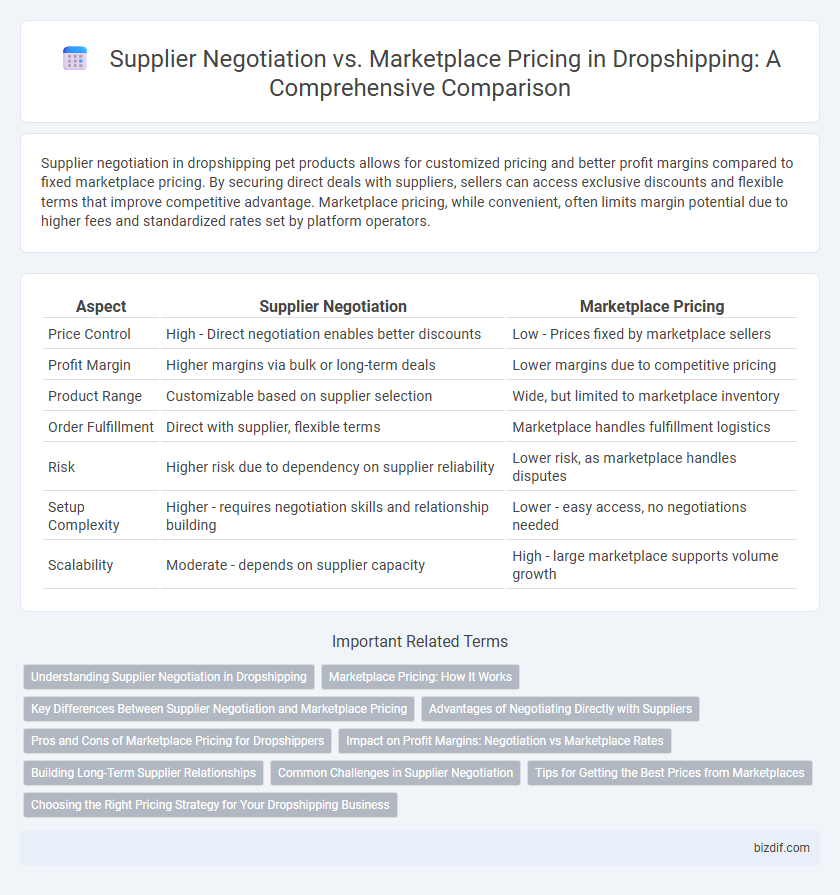Supplier negotiation in dropshipping pet products allows for customized pricing and better profit margins compared to fixed marketplace pricing. By securing direct deals with suppliers, sellers can access exclusive discounts and flexible terms that improve competitive advantage. Marketplace pricing, while convenient, often limits margin potential due to higher fees and standardized rates set by platform operators.
Table of Comparison
| Aspect | Supplier Negotiation | Marketplace Pricing |
|---|---|---|
| Price Control | High - Direct negotiation enables better discounts | Low - Prices fixed by marketplace sellers |
| Profit Margin | Higher margins via bulk or long-term deals | Lower margins due to competitive pricing |
| Product Range | Customizable based on supplier selection | Wide, but limited to marketplace inventory |
| Order Fulfillment | Direct with supplier, flexible terms | Marketplace handles fulfillment logistics |
| Risk | Higher risk due to dependency on supplier reliability | Lower risk, as marketplace handles disputes |
| Setup Complexity | Higher - requires negotiation skills and relationship building | Lower - easy access, no negotiations needed |
| Scalability | Moderate - depends on supplier capacity | High - large marketplace supports volume growth |
Understanding Supplier Negotiation in Dropshipping
Supplier negotiation in dropshipping centers on establishing favorable terms such as pricing, shipping times, and return policies directly with manufacturers or wholesalers. Mastering negotiation techniques can lead to lower costs and exclusive deals that outperform fixed marketplace pricing. Effective communication and long-term relationship building with suppliers enhance profit margins and provide a competitive edge in the dropshipping business model.
Marketplace Pricing: How It Works
Marketplace pricing operates by aggregating product prices from multiple suppliers, allowing sellers to set competitive prices based on real-time market demand and supply data. Algorithms analyze factors such as competitor pricing, sales velocity, and inventory levels to dynamically adjust prices, maximizing profit margins while maintaining customer appeal. This automated pricing strategy reduces the need for direct supplier negotiation, streamlining the dropshipping process and enhancing scalability.
Key Differences Between Supplier Negotiation and Marketplace Pricing
Supplier negotiation allows for customized pricing, bulk discounts, and exclusive deals tailored to individual business needs, enhancing profit margins. Marketplace pricing is generally fixed, transparent, and influenced by competitive dynamics with numerous sellers, leading to standardized rates and less flexibility. Businesses leveraging direct supplier negotiations can secure advantageous terms that are often unavailable on marketplaces, impacting inventory costs and overall pricing strategy.
Advantages of Negotiating Directly with Suppliers
Negotiating directly with suppliers in dropshipping enables access to better pricing, exclusive discounts, and customized agreements that marketplace pricing often lacks. This direct communication fosters stronger business relationships, improving reliability and lead times while allowing flexibility in product selection and terms. Bypassing marketplace fees also increases profit margins, making supplier negotiation a strategic advantage for competitive pricing.
Pros and Cons of Marketplace Pricing for Dropshippers
Marketplace pricing offers dropshippers instant access to competitive prices and a broad product range without the need for direct negotiation, simplifying inventory management. However, reliance on marketplace pricing can result in lower profit margins and limited control over pricing fluctuations, which may affect overall business stability. Dropshippers benefit from quick scalability but face challenges in differentiation and vendor dependency due to standardized pricing structures.
Impact on Profit Margins: Negotiation vs Marketplace Rates
Negotiating directly with suppliers often secures lower costs per unit, reducing expenses and increasing profit margins compared to fixed marketplace pricing. Marketplace rates tend to include platform fees and standardized prices, which can compress margins and limit pricing flexibility. Effective supplier negotiation enables tailored deals, bulk discounts, and exclusive terms that significantly enhance profitability in dropshipping operations.
Building Long-Term Supplier Relationships
Building long-term supplier relationships in dropshipping enhances pricing stability and product quality beyond fluctuating marketplace rates. Negotiating directly with suppliers allows for customized terms, bulk discounts, and exclusive deals that marketplaces often cannot offer. Prioritizing trust and communication fosters collaboration, resulting in better profit margins and reliable inventory management.
Common Challenges in Supplier Negotiation
Supplier negotiation in dropshipping often faces challenges such as inconsistent pricing structures, limited transparency on product costs, and difficulty securing favorable terms without volume commitments. Suppliers may impose minimum order requirements or strict return policies, complicating flexibility for dropshippers. These obstacles can lead to higher expenses and reduced profit margins compared to the fixed pricing models commonly seen on marketplaces.
Tips for Getting the Best Prices from Marketplaces
To secure the best prices from marketplaces for dropshipping, research multiple suppliers to compare offers and identify competitive rates. Leverage bulk purchasing and request volume discounts to reduce per-unit costs while maintaining supplier reliability. Utilize data on market trends and demand fluctuations to time purchases strategically, maximizing cost efficiency.
Choosing the Right Pricing Strategy for Your Dropshipping Business
Choosing the right pricing strategy for your dropshipping business involves comparing supplier negotiation benefits against marketplace pricing standards. Negotiating with suppliers can lower product costs, increasing profit margins and allowing more competitive retail prices. Conversely, aligning prices with marketplace trends ensures competitive positioning and attracts price-sensitive customers while maintaining market relevance.
Supplier Negotiation vs Marketplace Pricing Infographic

 bizdif.com
bizdif.com